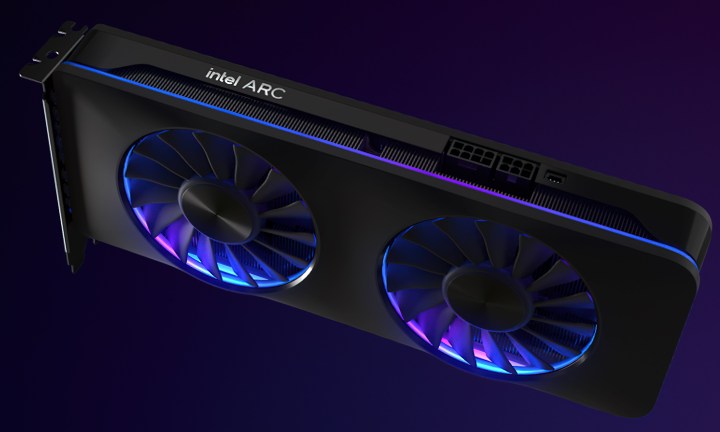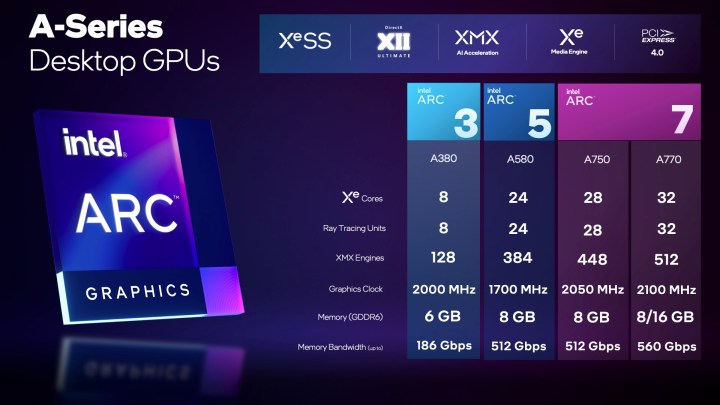Today is a big day for Intel Arc Alchemist — the official specifications of the graphics cards have finally been revealed, confirming some previous speculation, but not without one unexpected announcement.
Although Intel has mostly focused on the Arc A770 and the Arc A750, it will actually launch another GPU, too, the seemingly forgotten Arc A580. What can we expect from these GPUs and will they be competitive enough to capture the interest of Nvidia and AMD customers?

After quite a long wait, Intel didn’t hold back and told us most of the things we need to know about its discrete GPUs. Three graphics cards are on the way, and all three will utilize the same top-of-the-line ACM-G10 Alchemist GPU die. While we knew about the Arc A770 and A750 and got to see their performance in various videos with Intel’s Ryan Shrout and Tom Petersen, the Arc A580 was always a bit of an enigma in comparison, overshadowed by its two better siblings.
First, we have the flagship Arc A770, featuring the full 32 Xe-Cores and 32 ray tracing units. It will come in both 16GB and 8GB memory versions and offer maximum memory bandwidth of 560Gbps. The GPU has a 256-bit bus interface and a clock speed of 2.1GHz, powered by a TDP of 225 watts.
The Arc A770 is expected to be a rival to Nvidia’s GeForce RTX 3060 Ti, and if all goes well, it might even offer better performance than the Nvidia offering. Of course, the performance metrics will differ from game to game depending on the API — Intel GPUs shine when DirectX 12 and Vulkan are involved, but may have a hard time with DX11/9 games.
Next is the Arc A750. While it runs on the same ACM-G10 GPU die, it comes with 28 Xe-Cores and 28 ray tracing units. Just like the Arc A770, it features a 256-bit memory bus and the same 225-watt TDP. However, it will max out at 8GB memory, a clock speed of 2,050MHz, and an effective bandwidth of 512Gbps. This graphics card will be positioned against Nvidia’s RTX 3060.
Both of these graphics cards will be released in Limited Edition versions (which is Intel’s own design) and custom flavors prepared by Intel’s yet-unnamed board partners. Intel won’t be releasing any more powerful GPUs in the Arc Alchemist lineup, so Nvidia’s and AMD’s high-end

Lastly, we have the Arc A580, with 24 Xe-Cores and 8GB of memory, although yet again, the same ACM-G10 die. The clock speed was rated at 1.7GHz combined with a memory bandwidth of 512Gbps, all across a 256-bit bus. This GPU will offer a similar performance to the RTX 3050.
Intel plans to release the Arc A770 and the Arc A750 (this time globally) this month, so we’re not far off. The Arc A580 is said to follow later this quarter. As for the prices, Intel has promised to keep them competitive, so if it can hit lower pricing segments, it could still be competitive against its rivals in that way.
Assuming that Intel can price the Arc A770 to be cheaper than $400, the Arc A750 under $350, and the Arc A580 closer to $200-$250, the GPUs would still rank pretty highly compared to other budget graphics cards. Let’s wait and see — it can’t be long now until Intel confirms the official pricing.
Editors' Recommendations
- Intel surprise launched a new graphics card, but it doesn’t make any sense
- Intel’s forgotten Arc GPU might still have some life
- Here’s how Intel doubled Arc GPUs’ performance with a simple driver update
- Intel’s future GPUs just got revealed in a major leak
- Intel just gave your Arc GPU double the frames-per-second performance



